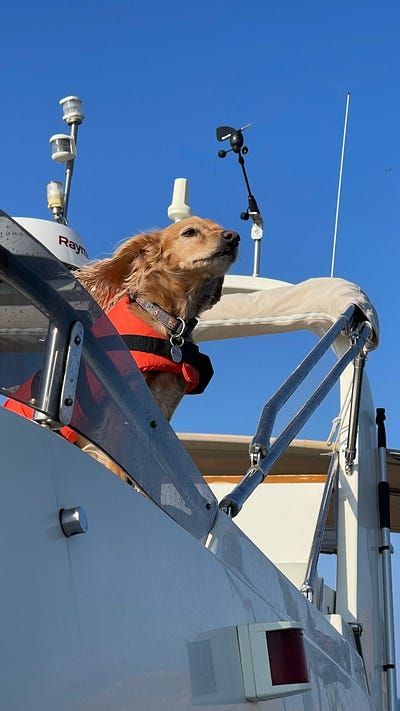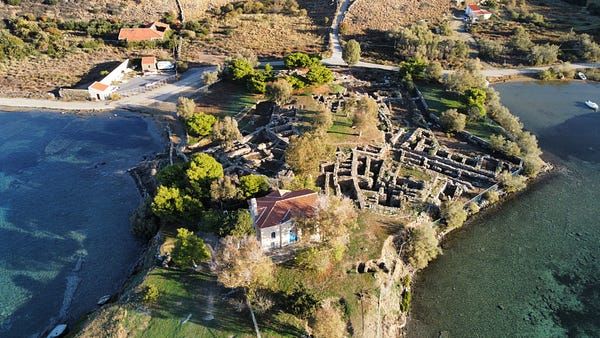Week 64 - Fogged in
Fogged in and things that go bump in the night exploring the Cyclades. Adventures in Greece cruising the Mediterranean on our boat Matilda.

Fogged in and things that go bump in the night exploring the Cyclades. Adventures in Greece cruising the Mediterranean on our boat Matilda.
It’s been an incredible week actually. The weather has been sensational, a lovely 20–25C each day, wind has been generally calm and we’ve been able to travel to several new islands.


The Cyclades is renowned as being a challenging place to visit by boat because of the north wind, the “Meltemi”, which comes down from the Black Sea and the north of Russia, blowing through the islands between Turkey and Greece. During Summer it’s consistent and relentless and makes things particularly challenging for a boat like ours. This late in the year it comes in bursts and we can find good weather windows in which to move around.
The Cyclades are also “classic tourist” Greece. When you think of white houses and blue roofs overlooking stunning sea views and clear waters, this is the Cyclades. Santorini, Milos, Paros and Naxos are all in the Cyclades. Like most places in Greece, each island, even though it’s usually only 20–30 kilometres away from its neighbour has some differences and a unique feel.

Broadly speaking however, there are a lot of similar themes too. The islands have all been inhabited for thousands of years, there’s not a centimetre of ground that feels “untouched”. You know you’re walking somewhere that’s had people here before. No rock is unturned, no tree unharvested, no parcel of land unfenced. There’s a strong sense of history with people’s connection to the land and the way they use it.


Throughout history the islands were largely left to their own devices — neglected by the centres of power on the mainland because, beyond maybe being a convenient place to pop a castle, there was not much there. Most of the islands experienced piracy and consequently the “Chora” (they all have a “Chora” which is the main / historical main village on the island) was up the top of a hill away from the coast for protection.

During the industrial revolution there was typically a burst of economic prosperity when gold, silver, iron, coal or some other desirable resource was discovered and able to be exploited, but that usually died out by around the end of World War II, leaving behind empty mines and the crumbling remnants of industrial infrastructure which litter the coast lines of many of the islands. Sometimes it’s not visible at all, but could be a marking on a chart or a comment on a pilots guide “Beware the old chain across the bottom of the harbor which used to moor the coal ships”, which is all fine until it’s your anchor that gets hooked up on it!
Most of the islands then went through a long period of declining population until they were “re-discovered” by Athenians and they’ve re-vitalised themselves as a tourist destination. Some islands (like Santorini and Mykonos) are very much international now attracting tourists from all over the world, while others, like Kea, Kythnos, Sifnos and Serifos where we were this week, are more local in nature — predominantly catering to locals with some more adventurous travellers or the charter crews.
Monday morning we crossed from the coast of Attika (Athens region) to Kea. After the more challenging weather of last week, it was a pleasure to just be able to sit back on auto-pilot and relax as we headed to a new location. We found a lovely port in Vakari which was very quiet. When we asked where to eat, the local guide said “there, everything else closed last week”. It’s definitely now the end of the season.


We enjoyed walking around the harbour and visiting the small ruin of a Mycanean settlement (1,500 BC) and then caught a taxi to the Chora, our first of many during the week! Kea’s Chora is stunning — perched on a hill with no access to cars, you genuinely feel like you could be 150 years in the past. It’s magical being somewhere that’s inhabited and functioning, but also has a genuine “out of time” feeling, where it seems very authentic. An interesting feature near the Chora is the Lion of Kea, a large lion carved in a rock which no-one really knows why, but is dated to around 600BC. As an interesting side note, lions existed on main land Greece up until around the 4th century AD.



After two nights at Kea, we left on Wednesday morning to cross to Kythnos, the next island in the chain to the south-east. We’ve been here before (on our first trip with Camille and Giorgio back in August) and this is where despite the sameness of the histories, there are unique differences on each island. I commented to Karina that “these walls remind me of Kythnos” forgetting that we were literally on Kythnos at the time. Indeed, there is a particular type of stone wall that’s unique to Kythnos and covers the island on both sides!
A highlight in Kythnos was the hot springs in the port of Loutra. The water temperature is about 38C, and it runs into the sea where a small pool has been created with rocks — you can choose the temperature gradient you want to bath in. It’s very relaxing and a great experience. We’ll definitely visit again if our travels back towards Athens take us that way. We also walked up the hill to the Chora, which while interesting enough wasn’t as stunning as the one on Kea.


Thursday afternoon we left Kythnos and cruised down to Serifos where we anchored out in a large bay on the north side of the island. It was very peaceful and somewhat amusing because in the morning there was a naked man roaming the rocks for over an hour searching for… something in the water.
The most amazing site however was the fog. When we woke up the entrance to the bay was shrouded in very heavy sea fog. We decided to wait and see if it would lift before heading around to the south side of Serifos. After an hour or so it seemed to ease and we got under way.


It turns out that it didn’t lift at all! Once we were off the coast it closed in again and at one stage for about 10 minutes, we could only see 30 metres or so in front of the boat. Fortunately we have good electronic charts and GPS, so we know exactly where we are and we have a radar so we know exactly where everyone else is, and of course we sounded our horn every 2 minutes as we travelled along. We made it to the harbor on the south and as we entered, the fog cleared again allowing us to dock easily.


The fog came in and out of the harbour throughout the day, which was very spooky. The biggest challenge is the damp! Everything was wet — water was condensing and dripping off fly screens, pooling on the canvas bimini, your hair felt damp and even the bedding was damp to touch that night. We ran the heater on the boat for the first time “for real” to try and dry out and warm up.
It did make for some stunning pictures from the top of the Chora however, looking south toward Sifnos, you could just see white. We were told by locals that it’s been 20 years since this had happened — it takes a very specific set of conditions for the fog to appear like that which are exceedingly rare. By Friday, it had disappeared again.

Overnight in the fog, we heard some bumps on the boat which turned out to be local cats boarding us! We’ve found the cats in the Cyclades are a lot more aggressive, they will happily walk on to the boat, scratch at you for food or even try jump onto your lap when you’re eating. I’m not sure if it’s that the cats here are just more aggressive in general or if it’s because at the end of the tourist season, there’s less food around (tourists feeding them at dinner) and so they are actually getting hungry and having to search more to eat. As I type this we’ve literally pulled up our passerelle to stop a local cat from boarding — it’s currently sitting on the dock meowing at us!
From Sifnos, we hopped down to Serifos on Saturday morning where we are currently moored in the small sheltered port of Vathi, waiting out a day of north winds. It’s very quiet with only two other boats here. No more charter boats, just other owner/sailors. It’s a very quaint, peaceful town which we’ll enjoy pottering around in waiting out the weather for tomorrow.
Tomorrow we head to Kimolos, a small island off the north coast of Milos and then Tuesday afternoon we’re heading into Milos and the main port to wait out the North wind which will run for several days. It will be our first time on one of the really big tourist islands, so it’s going to be interesting to spend a couple of days there and see what it feels like compared to the others we’ve experienced.
Want to see where we are now? Check us out on NoForeignLand https://www.noforeignland.com/boat/matilda
Until next time,
Tim & Karina
